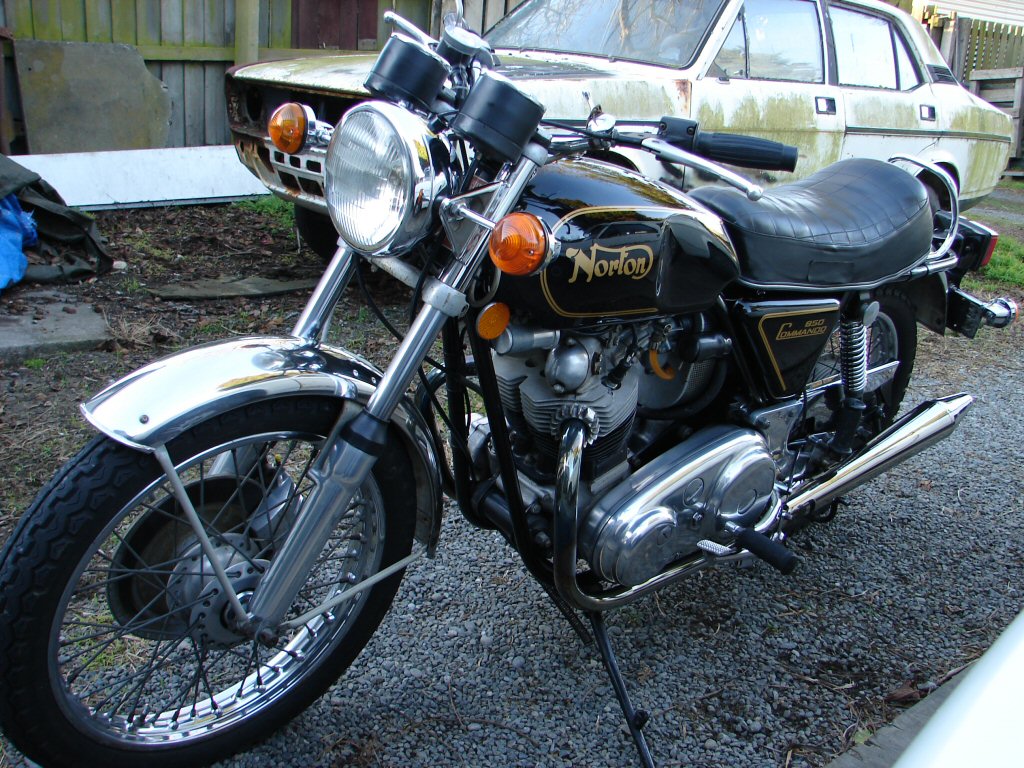1974 Norton Commando 850

September 2019
This beauty belongs to a mate and we covered some miles last weekend. I could see it started and ran well, but he had some complaints about the tuning.
One night during the week I delivered his T150 after some work and rode the Norton home to see if I could improve things. Took me a mile or two to remember how to speak Norton, as it has been quite some years since I owned a couple of them.

One immediately notices how slim and light these bikes feel compared to the Trident you just stepped off. I also remembered how the gearchange works - easiest if you think of rolling the gearlever forward to change up and rolling it backwards to change down. It becomes natural very quickly then.
The tuning issue became apparent within the first few roundabouts, as a quick blip of the throttle to change down elicited nothing more than a huge gulp and a pop from the exhaust or carbs - I could not decide which but both meant the same. There was a lot of leanness going on above about 1/8 throttle. Giving it some extra encouragement to around half throttle and there were signs of more life, but to me being new to the bike and all, it still felt less than happy to be wanting to give its best.
I was going to need to look inside the carbs.

Thinking I needed to remove them I unfortunately removed the airfilter first, only to discover what an unpleasant job that is. I then found I could extract the slide out the top of the left side carb which meant that had been 50% unneccesary, although the right carb was partially occluded by wiring loom and other stuff, so I would probably need to remove that one. The more I looked at it, the less I wanted to remove it at all, so with some extra dexterity of the kind resulting from sheer horror of the alternative I was able to coax it out. Great.
These were quite new Amal Premiers supplied by one of the UK's leading Norton spares experts as being perfect for the job. They had not been. Another mechanic had spent some time attempting a cure and had commented that the carbs had the wrong internals. Indeed, the nice hard anodised slides were No.3 where they should have been No.3½ - and these would normally be too rich for an 850, more for 750's. However, I have found that there is a tendency for these new type slides to perform as if they were half a size leaner, so using No.3 may have been a gifted choice. The needles however were otherwise. They were two stroke needles of the same type used by the T160 Trident, the adoption of which was to curb the fuel appetite which was becoming less favoured in the USA with its new emission regulations of the mid 70's. The Mk3 Commandos used these needles in conjunction with spray tubes that were cut away on an angle, thus supplying the extra fuel that the needle was not. On this bike though, the spray tubes were flat topped, so the more common 4 stroke needles such as the T150 Trident type should have been fitted here. As I had a new set for a Trident I fitted 2/3 of them into these carbs, and because I felt that the degree of lean was well developed I set them on the richest clip position with the needles at their highest.
The carbs went back together easily although it was a carefully controlled manoeuvre to get the airfilter all back in place and happily connected to the carb mouths.
The other thing I was rusty about on Nortons was starting them. I experimented a bit with the key off first until I was happy I had found the sweet spot where it was worth giving it a hefty kick to see what might happen. It took me a few goes until I realised that with the excessive freeplay in the throttle cable I was not really giving it much gas on the way through, so I modified that and it lit up straight away. When I was synchronising the carbs I tried to remove some of the slack but all the adjusters were already at max. Just a learning curve on somebody else's bike.
Mind you, the kickstarting process is made enormously easier by it being such a slim and lightweight bike when compared to all the 3 cylinder and more offerings of the same era.

Having gotten it running and found it to be pretty happy with idling a test ride was in order. It took a short distance to warm up and a few trial blips when changing revealed that we had a much happier bike. Rolling the throttle on from a few thousand revs also gave me the impression that the bike was much more eager to pick up revs, so I will be interested in the owners observations when he rides it next.
I did not ride it very far although I did manage some 70mph briefly and it felt to be happy throughout the rev range. Once or twice I got a milder version of the hesitation when giving it a blip from very low revs, but otherwise I could not catch it out and the idle was very stable when sitting. Any further progress would now involve messing with the needle jets, and I have had major issues of late with the quality of same, so I decided to give the bike back and see if he could now live with it.

I was happy to be returning it after only 24 hours, although it was not a big job really. It is often a bigger job trying to decide what changes are going to be needed, but the symptoms here made me certain what needed doing to begin with, then the discovery of the lean needles was the corroborating evidence I needed to feel confident this would get the desired result.
Lets hope we did.